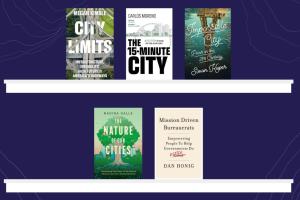 Read More
Read More
5 summer reads for urban innovators

Listen to This Article
Ready to dig deeper for new knowledge, insights, and action items on the frontier of local-government innovation? It’s been a prolific season for exciting new books about cities, public service, and how leaders can work with residents to drive progress. Check out Bloomberg Cities’ latest list of new books for urban innovators for fresh perspectives on everything from how to build stronger cultures of commitment in city halls to the next generation of nature-based solutions.
City Limits: Infrastructure, Inequality, and the Future of America’s Highways
By Megan Kimble
It’s not hard to find a diatribe about the ills of so-called “car culture” in America, but in her new book, Megan Kimble tells a much richer and more hopeful story. She dives into the growing movement to, as she puts it, “recalibrate our bargain with speed.” Specifically, Kimble highlights how local leaders, advocates, and residents are taking new looks at big infrastructure projects—and how they can be used to unite, rather than physically divide, communities. She emphasizes one effort in particular to remove an albatross in Rochester, N.Y., where, she writes, it is now “possible to forget the highway ever existed.” Along the way, she spends time with the local leaders on the ground helping chart the future of urban progress.
Impossible City: Paris in the Twenty-First Century
By Simon Kuper
In his new book, Simon Kuper does more than write a love letter to Paris—he offers a vision of what cities can aspire to. From major improvements in cycling infrastructure under the leadership of Mayor Anne Hidalgo to a more complicated effort to bolster social solidarity between outlier communities in the migrant-heavy suburbs—or banlieues—and the city center, he charts progress while staying clear-eyed about the challenges cities face. As Kuper writes, “A diverse population by itself isn’t enough to make a city diverse.” Instead, leaders have to make it so.
The 15-Minute City: A Solution to Saving Our Time and Our Planet
By Carlos Moreno
When the city council in Cleveland unanimously approved a pilot program to explore a new approach to zoning last month, Carlos Moreno had something to do with it. The intellectual godfather of “the 15-minute city”—the idea that a city’s essential services should be accessible within a short (quarter-of-an-hour) trip on foot, by bike, or via public transit—Moreno has come a long way since debuting his idea at the COP21 climate conference nearly a decade ago. In his new book, he traces gains local leaders are making on these issues from Buenos Aires to Milan to Melbourne. As he writes, this is a journey defined by "urban challenges, innovations, and triumphs, showcasing the embrace of proximity principles across five continents.”
Mission Driven Bureaucrats: Empowering People To Help Government Do Better
By Dan Honig
Local leaders are increasingly working to turn talent management from a compliance exercise into a strategic function, and in that sense, Dan Honig’s new book couldn’t be better-timed. The Georgetown and University College London scholar uses the term “bureaucrat” pointedly, determined to prove that the common perception of many people in government as somehow uncaring is dead wrong. He looks closely at how leaders and their teams can get mired in cultures of mandates, but also offers practical steps leaders can use to motivate and inspire. Honig calls it “managing for empowerment”—and any leader determined to inject new urgency into their city hall will find a lot to chew over here.
The Nature of Our Cities: Harnessing the Power of the Natural World to Survive a Changing Planet
By Nadina Galle
If you’re tired of hearing about the same old approaches to nature-based solutions, this is the book for you. Ecological engineer Dr. Nadina Galle writes inspiringly of new and emerging innovations that can help cities meet the existential threats posed by climate change, such as artificial intelligence-powered tools that help keep wildfires out of downtowns. She also offers an optimistic vision of cities and nature living together in greater harmony—and reminds us that even something as simple as planting more trees requires deliberate engagement, so leaders and residents are on the same page about their collective future.
